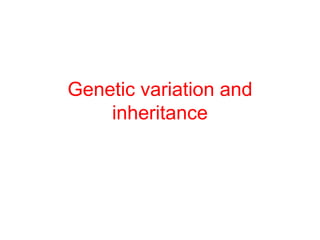Genetic variation and inheritance
•Télécharger en tant que PPTX, PDF•
9 j'aime•8,779 vues
Signaler
Partager
Signaler
Partager

Recommandé
Recommandé
Contenu connexe
Tendances
Tendances (20)
Chapter 19 Heredity Lesson 5 - Discontinuous and Continuous Variation

Chapter 19 Heredity Lesson 5 - Discontinuous and Continuous Variation
Modification of Normal Mendelian ratios with Lethal gene effcets and Epistasis

Modification of Normal Mendelian ratios with Lethal gene effcets and Epistasis
En vedette
En vedette (6)
Similaire à Genetic variation and inheritance
Similaire à Genetic variation and inheritance (20)
PRINCIPLES OF INHERITANCE Class XII Biology Part I

PRINCIPLES OF INHERITANCE Class XII Biology Part I
B4FA 2012 Nigeria: Principles of Genetics - Charles Amadi

B4FA 2012 Nigeria: Principles of Genetics - Charles Amadi
Plus de Steve Bishop
Plus de Steve Bishop (20)
Genetic variation and inheritance
- 1. Genetic variation and inheritance
- 2. Genetic variation and inheritance Key words Cell Chromosone Nucleus Gene Sexual reproduction Asexual reproduction Gamete Zygote Clone Propogation Binary fusion Genetic factors Environmental factors
- 3. Genetic material •A cell is the basic unit of life; all organisms are made up of cells. •The nucleus is a large organelle found in all cells, that contains the genetic information. •Chromosomes are thread-like structures made of DNA found in the nucleus. •Genes are small sections of a chromosome that control the characteristics of an organism. • These are passed on from parent to offspring, resulting in offspring of plants and animals having similar characteristics to their parents. Eg hair colour and petal colour • Different genes control the development of different characteristics of an organism.
- 4. C B D A E
- 5. Sexual reproduction •Involves two parents. •They produce male and female sex cells (gametes). •In humans these are sperm and eggs. •In plants these are pollen and ovules •Fertilisation occurs - the joining (fusion) of male and female gametes. •The mixture of the genetic information from two parents leads to variation in the offspring. •Genes are passed on in the gametes, from which the offspring develop.
- 6. Asexual reproduction •Involves only one individual as a parent. •There is no fusion of gametes. •There is no mixing of genetic information and so no variation in the offspring. •These genetically identical individuals are known as clones. Examples: •Bacteria or yeast cells use binary fission •Plants can use runners, bulbs or vegetative propagation. •Some invertebrate animals like starfish and hydra can produce asexual offspring.
- 7. The causes of variation Differences in the characteristics of different individuals of the same kind may be due to differences in: • the genes they have inherited (genetic causes) • the conditions in which they have developed (environmental causes) • or a combination of both. Genetic factors Sexual reproduction - leads to genetic variety in the offspring. All offspring (except for identical twins) inherit different characteristics. Asexual reproduction – no genetic variation in the offspring (unless mutations occur) Environmental factors •Nutrition •Temperature •Light •Physical forces